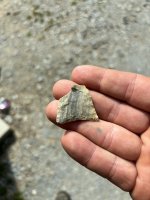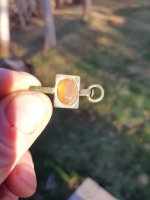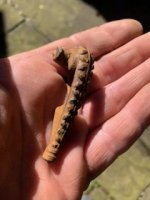Gypsy Heart
Gold Member
SUBSCRIBE TO
http://www.dailytribune.com/stories/020305/lif_silver03001.shtml
By Christy Strawser
Daily Tribune Staff Writer
PUBLISHED: February 3, 2005
English explorer Alexander Henry came to the Upper Peninsula in the 1770s to find gold and silver, but he found only copper, which he considered worthless.
He gave up. And that's where the real story begins.
Berkley native Richard Kellogg, 79, starts an extraordinary yarn at that point, weaving in a fantastic voyage, buried treasure, hidden silver mines, and a case of back stabbing in America's early days that he thinks changed the
course of history.
His twists and turns seem unbelievable, from saving his business with help from a geologist friend with a secret past to lowering himself into a sparkling cavern of pure silver dug deep into the Upper Peninsula.
But Kellogg swears it's all truth, not fiction. He recounts his tales in the book, "A Silver Wall," which got a boost of national attention Wednesday when Kellogg's story was featured on a national Public Broadcasting System show. The documentary will re-air at 10 a.m. Saturday and 1 p.m. Wednesday on public TV.
Kellogg said his book was already a bestseller in Michigan before the World War II veteran and 1944 Royal Oak High School graduate made his nationwide pitch. His book reportedly has U.P. shopkeepers bracing for a spring rush of treasure hunters.
And it all started with a speckled trout.
Kellogg had retired from General Motors, moved to the Upper Peninsula and bought a sports bar when he stumbled on the man who would change his life. Kellogg said his bar was in trouble by the early 1970s, because local miners were on strike and couldn't afford to lift a pint at his neighborhood watering hole.
"Then a gentleman came into where I was, and I had never seen him before," Kellogg said. "He had just come back from England. He stopped near a trout mounted in a glass case in the bar. He said it was his speckled trout, that he had been in the bar the day it opened and they mounted it."
From that encounter, the men became friends and Kellogg shared his bar's financial troubles. The new pal had Kellogg's full attention when he said he knew just how to save the tavern.
"He brought a footlocker full of silver to the bar. There were over 30 pieces in it at that time and he told me I could have it," Kellogg said. They agreed to sell it and split the profit evenly.
Staggered by the generosity, Kellogg said he sold the silver the man gave him and it was more than enough to pay off the bar's debts and stay in business.
"Less than two weeks after I got the silver, I had enough money to save my business," Kellogg said. "He saved me."
The catch
But his friend had one string attached. He didn't want repayment in money. Rather, he wanted Kellogg, a gifted storyteller with a lilting, melodic voice, to write his life's story.
The story he told had Kellogg reeling.
"He was a geologist, he was paying somebody to take care of his grandfather, and he went out to look for precious metals. He was known as a collector of precious metals," Kellogg said. "Then he said he had found this mine in 1927."
The friend, whose name Kellogg changed to protect his family, said blowing smoke at his campfire on a treasure-hunting expedition had led him to a pile of wood that protected an ancient mine. He went down and found a wall of silver in the deep mine near Calumet in the Upper Peninsula.
Kellogg's buddy went back to the mine several times, he said, furtively hauling out 17 barrels of pure silver. He funneled the silver through a gangster family in Chicago and gave up his exploits at the mine when he had enough money to stay comfortable for life.
He hadn't been back since the 1930s, but Kellogg insisted that he wouldn't write the man's story unless he could prove the mine really existed.
"So in June of 1971, he took me to it," Kellogg said.
The man had left a marker near the hatch of the mind-boggling mine, Kellogg said, and armed with flashlights and other mining gear, the two lowered themselves into the ancient hole.
It was dark and cold, scary, going down to the floor of the mine. Dripping with cold sweat, Kellogg said he seemed so overwrought that his friend offered to take him back up before they found what they were looking for. Kellogg stayed.
"It was total darkness," Kellogg said. "I was so fearful that my whole body was saturated. It was unbelievable. Then we finally saw it."
Seeing the wall
He said it looked like a wall of silver shimmering behind a layer of crystals.
"This whole cavity — you could get a house inside it. It was huge and all sided with crystal with silver behind it. I had a maxi flashlight and that's what I used to look at it. It's about 90 feet long, I guesstimated, down there."
Kellogg said he stood by while his friend dug out a large box full of bags of gold coins that he had bought with his windfall in silver and buried under a pillar. He gave two full bags to Kellogg to pay him for writing the book and re-buried the rest for treasure hunters to find.
Kellogg said he was awed by the money and then floored when he read an inscription scratched into one of the walls of the old mine.
"It says June 6, 1774," Kellogg said.
Using that date and old journals, he researched the history of his wall of silver and came to this conclusion: Sabin Stone, geologist in Alexander Henry's 1770s expedition, discovered the silver, but kept quiet.
After Henry gave up, Stone remained behind to mine the Cliffs region and found a motherlode. But there was a collapse at some point that rendered the old entrance unusable, Kellogg said, and kept the old mine under wraps.
Only the escape hatch still exists today.
"Had the mine been put into production, there may not have been a United States of America as we know it today," the book says.
Silver in those walls
Kellogg moved to Traverse City after his mine expedition, sold his bar, and said he's never returned. He said he's too old to make the trek back, but he put the general coordinates in his book to keep treasure hunters busy.
And he said he left his calling card inside the old mine.
"I dropped in my World War II dog tags," Kellogg said. "And there's a note."
Kellogg said the note directs its finder to donate money to charity in his old pal's memory.
He keeps readers guessing about the exact location of the mine, but he put a general map in the book and finishes his tale with tantalizing tidbits to keep treasure hunters coming back for more.
"The mine's entrance is concealed to blend in with nature," Kellogg writes in his book. "With the use of smoke to detect the draft coming from underground, you might get surprisingly lucky."
http://www.dailytribune.com/stories/020305/lif_silver03001.shtml
By Christy Strawser
Daily Tribune Staff Writer
PUBLISHED: February 3, 2005
English explorer Alexander Henry came to the Upper Peninsula in the 1770s to find gold and silver, but he found only copper, which he considered worthless.
He gave up. And that's where the real story begins.
Berkley native Richard Kellogg, 79, starts an extraordinary yarn at that point, weaving in a fantastic voyage, buried treasure, hidden silver mines, and a case of back stabbing in America's early days that he thinks changed the
course of history.
His twists and turns seem unbelievable, from saving his business with help from a geologist friend with a secret past to lowering himself into a sparkling cavern of pure silver dug deep into the Upper Peninsula.
But Kellogg swears it's all truth, not fiction. He recounts his tales in the book, "A Silver Wall," which got a boost of national attention Wednesday when Kellogg's story was featured on a national Public Broadcasting System show. The documentary will re-air at 10 a.m. Saturday and 1 p.m. Wednesday on public TV.
Kellogg said his book was already a bestseller in Michigan before the World War II veteran and 1944 Royal Oak High School graduate made his nationwide pitch. His book reportedly has U.P. shopkeepers bracing for a spring rush of treasure hunters.
And it all started with a speckled trout.
Kellogg had retired from General Motors, moved to the Upper Peninsula and bought a sports bar when he stumbled on the man who would change his life. Kellogg said his bar was in trouble by the early 1970s, because local miners were on strike and couldn't afford to lift a pint at his neighborhood watering hole.
"Then a gentleman came into where I was, and I had never seen him before," Kellogg said. "He had just come back from England. He stopped near a trout mounted in a glass case in the bar. He said it was his speckled trout, that he had been in the bar the day it opened and they mounted it."
From that encounter, the men became friends and Kellogg shared his bar's financial troubles. The new pal had Kellogg's full attention when he said he knew just how to save the tavern.
"He brought a footlocker full of silver to the bar. There were over 30 pieces in it at that time and he told me I could have it," Kellogg said. They agreed to sell it and split the profit evenly.
Staggered by the generosity, Kellogg said he sold the silver the man gave him and it was more than enough to pay off the bar's debts and stay in business.
"Less than two weeks after I got the silver, I had enough money to save my business," Kellogg said. "He saved me."
The catch
But his friend had one string attached. He didn't want repayment in money. Rather, he wanted Kellogg, a gifted storyteller with a lilting, melodic voice, to write his life's story.
The story he told had Kellogg reeling.
"He was a geologist, he was paying somebody to take care of his grandfather, and he went out to look for precious metals. He was known as a collector of precious metals," Kellogg said. "Then he said he had found this mine in 1927."
The friend, whose name Kellogg changed to protect his family, said blowing smoke at his campfire on a treasure-hunting expedition had led him to a pile of wood that protected an ancient mine. He went down and found a wall of silver in the deep mine near Calumet in the Upper Peninsula.
Kellogg's buddy went back to the mine several times, he said, furtively hauling out 17 barrels of pure silver. He funneled the silver through a gangster family in Chicago and gave up his exploits at the mine when he had enough money to stay comfortable for life.
He hadn't been back since the 1930s, but Kellogg insisted that he wouldn't write the man's story unless he could prove the mine really existed.
"So in June of 1971, he took me to it," Kellogg said.
The man had left a marker near the hatch of the mind-boggling mine, Kellogg said, and armed with flashlights and other mining gear, the two lowered themselves into the ancient hole.
It was dark and cold, scary, going down to the floor of the mine. Dripping with cold sweat, Kellogg said he seemed so overwrought that his friend offered to take him back up before they found what they were looking for. Kellogg stayed.
"It was total darkness," Kellogg said. "I was so fearful that my whole body was saturated. It was unbelievable. Then we finally saw it."
Seeing the wall
He said it looked like a wall of silver shimmering behind a layer of crystals.
"This whole cavity — you could get a house inside it. It was huge and all sided with crystal with silver behind it. I had a maxi flashlight and that's what I used to look at it. It's about 90 feet long, I guesstimated, down there."
Kellogg said he stood by while his friend dug out a large box full of bags of gold coins that he had bought with his windfall in silver and buried under a pillar. He gave two full bags to Kellogg to pay him for writing the book and re-buried the rest for treasure hunters to find.
Kellogg said he was awed by the money and then floored when he read an inscription scratched into one of the walls of the old mine.
"It says June 6, 1774," Kellogg said.
Using that date and old journals, he researched the history of his wall of silver and came to this conclusion: Sabin Stone, geologist in Alexander Henry's 1770s expedition, discovered the silver, but kept quiet.
After Henry gave up, Stone remained behind to mine the Cliffs region and found a motherlode. But there was a collapse at some point that rendered the old entrance unusable, Kellogg said, and kept the old mine under wraps.
Only the escape hatch still exists today.
"Had the mine been put into production, there may not have been a United States of America as we know it today," the book says.
Silver in those walls
Kellogg moved to Traverse City after his mine expedition, sold his bar, and said he's never returned. He said he's too old to make the trek back, but he put the general coordinates in his book to keep treasure hunters busy.
And he said he left his calling card inside the old mine.
"I dropped in my World War II dog tags," Kellogg said. "And there's a note."
Kellogg said the note directs its finder to donate money to charity in his old pal's memory.
He keeps readers guessing about the exact location of the mine, but he put a general map in the book and finishes his tale with tantalizing tidbits to keep treasure hunters coming back for more.
"The mine's entrance is concealed to blend in with nature," Kellogg writes in his book. "With the use of smoke to detect the draft coming from underground, you might get surprisingly lucky."


 ? um nooo
? um nooo





